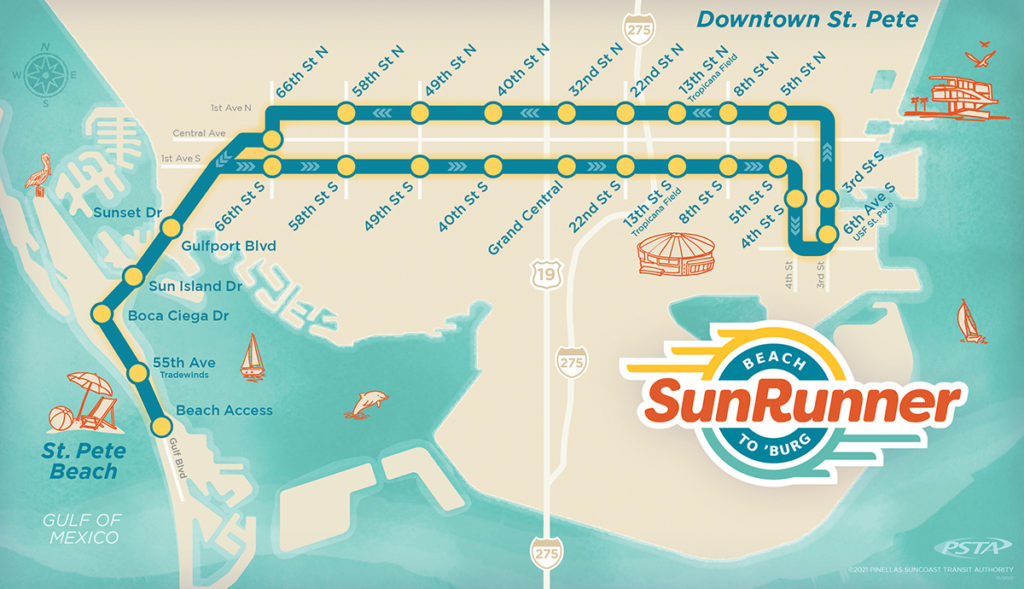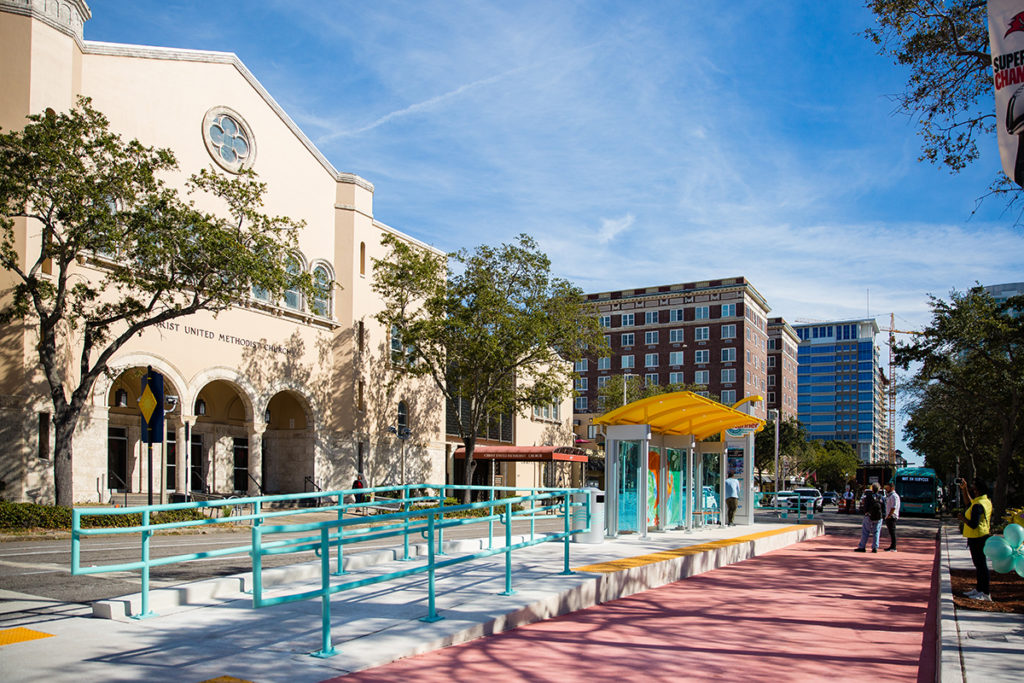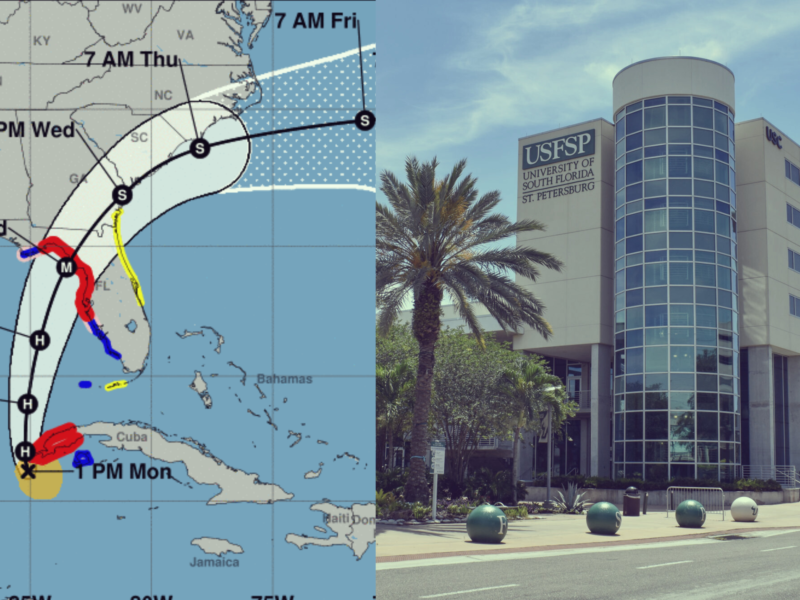The route will run west through South Pasadena up Gulf Boulevard into St. Pete Beach and east into downtown.
Courtesy of City of St. Petersburg
By Molly Ryan
In 2021, St. Pete Beach was rated the No.1 beach in the U.S. by Tripadvisor’s annual Travelers’ Choice rankings, but for residential students without a car at the USF St. Petersburg campus, it is typically not accessible without hitching a ride or taking a nearly $20 Uber.
With their arrival approaching, the SunRunner buses are expected to change that.
Opening this summer, the SunRunner will connect the 10.3 miles between downtown St. Petersburg and St. Pete Beach — projecting to cut the trip’s time down by 20 minutes.

Stand-alone lanes have been incorporated into First Avenue North and South to accommodate Tampa Bay’s first bus rapid transit (BRT) system: A bus-based transportation network designed to be more reliable and convenient than conventional bus systems.
According to former St. Petersburg mayor, Rick Kriseman, the idea of a more advanced public transportation system has been in the works since his first term in 2014.
“From the time I became mayor through the end of my term, I’ve always felt that mass transit was a real challenge for us in the Tampa Bay area,” Kriseman said in an interview with The Crow’s Nest. “It put us at a disadvantage to not have a real mass transit system, so it was important that [the city] started looking at how to move forward with some kind of system.”
However, it would not be until 2019 that the St. Petersburg City Council would commit $4 million toward the Pinellas Suncoast Transit Authority (PSTA)-led project.
With a budget of nearly $44 million — about $28 million of such sourced from several grants through the Federal Transit Administration —, each bus includes free Wi-Fi, air conditioning, on-board bike space, wheel-chair inclusive multi-door boarding and art by local muralist Chad Mize.
In addition to pay stations at each stop, prepay options will be available through the Flamingo Fares mobile app or card.
Offering rides every 15 minutes during the day and every 30 minutes in the evening, buses will follow a continuous route that runs west through South Pasadena up Gulf Boulevard into St. Pete Beach and east into downtown — one of its 27 confirmed stops residing in the heart of USF’s St. Petersburg campus at Third Street South and Sixth Avenue South.
Students like sophomore psychology major J.D. Dato believe the SunRunner will enrich the student experience at the St. Petersburg campus.
“The SunRunner will be a great asset to St. Pete students because it will give them a faster route to the beach and easier access to the restaurants and bars on Central Avenue,” Dato said. “They can enjoy the proven benefits of a BRT while paying student prices.”
According to the PSTA, some of the SunRunner’s projected benefits include increased foot traffic for local business and reduced traffic congestion — both of which Kriseman believes will have a positive domino effect on the economy and environment.
“Economic development is really important, but it’s also important to remember that one of the greatest challenges that we’re going to face over the next 50 years is climate change,” Kriseman said. “If we can do something to get people out of their cars using alternative forms of transit, that’s something that we’ve got to do. With the SunRunner, we’re getting away from fossil fuels and transitioning to electric, giving us a chance to decrease our carbon footprint.”
Kriseman also believes the SunRunner is a “needed first step” in the direction toward a more advanced Tampa Bay.

“When you go from no mass transit to mass transit, there’s a learning curve. It takes time for people to get used to that method of transportation,” Kriseman told The Crow’s Nest. “You’ll have low numbers the first year or two, but you’ll see a steady increase that will help educate us on how we do this bigger, how do we expand it and how do we connect with it and make it work better. But you have to take that first step.”
Dato feels that mass transit will prove “incredibly crucial” as the Tampa Bay area continues to grow.
“As people begin to move into the cities and surrounding suburbs, traffic and commute times will become more and more of a pressing issue,” Dato said. “Like St. Petersburg’s SunRunner, BRT has similar benefits to light rail, but is less expensive and time-consuming to implement.”
According to the World Population Review, St. Petersburg alone experienced a growth rate of 0.33% in 2020 — prompting the question of how to promote and develop mass transit in the Tampa Bay area makes itself known.
Currently, the Tampa Bay Regional Transit Authority (TBRTA) is conducting feasibility studies on other mass transit projects like a BRT system that would create a continuous route along the western portions of Pasco and Pinellas counties and an aerial gondola specific to Pinellas County.
Additionally, TBRTA proposed that the SunRunner could eventually be a part of a 41-mile route for the Regional Rapid Transit that would connect St. Pete Beach to Wesley Chapel with various stops throughout Tampa Bay.




You have to be exceptionally stupid to believe that this will do ANYTHING other than congest traffic, since it has removed and East/West travel lane. It will not relieve parking problems or congestion on the beaches and like every other bus in Pinellas County, it will drive back and forth mostly empty. Just a HUGE waste of taxpayer money.